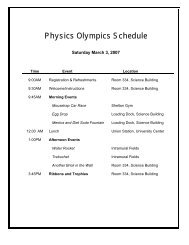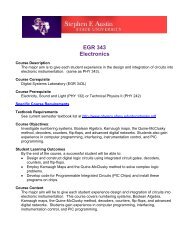PDF - Physics Syllabus
PDF - Physics Syllabus
PDF - Physics Syllabus
Create successful ePaper yourself
Turn your PDF publications into a flip-book with our unique Google optimized e-Paper software.
PHYSICS 101.001<br />
Instructor: Dr. N. L. Markworth<br />
email: nmarkworth@sfasu.edu<br />
Office Science 322F 468-3001<br />
Markworth’s Home Page<br />
Office Hours Summer II, 2010<br />
MTWR 02:00 - 04:00 PM Class Meets: 10:15 AM – 12:10 PM M-R<br />
Science 334<br />
Hot Links<br />
Purpose<br />
Materials<br />
EMAIL<br />
Exams<br />
Homework<br />
Participation<br />
This is a survey course which will familiarize the student with concepts of waves,<br />
sound, light, and mechanics. The major aim will be to give each student an<br />
appreciation and understanding of the physical universe. A conceptual rather<br />
than a mathematical point of view is emphasized.<br />
The text is Conceptual <strong>Physics</strong>, eleventh edition by Paul G. Hewitt (ISBN 0-321-<br />
56809-5). The readings indicated in the Course Outline (below) correspond to chapters<br />
from this text and should be read prior to discussion of the material in<br />
class. PHY 101L, the <strong>Physics</strong> Laboratory is a corequisite and a new edition of<br />
the lab manual is available in the bookstore. You will also need a clicker<br />
(personal response system device), which we use in both the lecture and lab. The<br />
clickers are available in the BPSC bookstore only.<br />
The course is fully developed in Blackboard. I will use the email system here<br />
since it is a closed email facility. All course business should be directed through<br />
Blackboard.<br />
There will be four major exams, each covering a limited amount of lecture and<br />
text material. The dates of these exams are listed in the course outline on the<br />
next page. Each student must provide a SCANTRON form number 882-ES in<br />
order to take each exam. The last exam will not be comprehensive. No makeup<br />
exams will be given except by EXCUSED absence. The last exam will<br />
contain special sections devoted to questions pertaining to the lab. See the lab<br />
syllabus for details.<br />
Students may improve exam score in two ways. Review questions will be<br />
assigned for each section of the course. Exam scores can be improved up to 10%<br />
through these assignments. Secondly, attendance will be taken daily, which can<br />
earn a total of five additional percentage points per exam.<br />
You must bring your clicker to class every day. Attendance will be taken using<br />
the clicker on most days during the first 60 seconds of class and throughout the<br />
class time. To make sure that you are going to arrive to class on time you can set<br />
your watch here: http://www.time.gov/. During class, we will engage in<br />
discussions and occasional activities using clicker technology (Turning Point<br />
XR). Participation in these activities will form part of your final grade. You<br />
cannot earn ‘class participation’ points if you don’t have a clicker. Do not let<br />
anyone else use your clicker. If you are observed using two clickers you will<br />
receive no credit for the ‘In-Class Participation Grade’ portion of your final<br />
grade. These devices are used to allow you to show your participation in the<br />
class. Therefore if you leave class after answering a clicker question it will result<br />
in a zero for that participation grade. If you are absent, late for class, or forget<br />
your clicker then you will get a zero for the participation grade for that day - but<br />
those days can be part of the clicker grades that are dropped.
Policies<br />
Grading<br />
For the benefit of your fellow students and your instructor, you are expected to<br />
practice common courtesy with regard to all course interactions. For example:<br />
□ Be considerate toward your classmates and instructor and arrive to class<br />
on time.<br />
□ Do not leave class early and do not rustle papers in preparation to leave<br />
before class is dismissed without speaking with your instructor first.<br />
□ Avoid classroom distractions. Be attentive in class: stay awake, do not read<br />
newspapers, etc.<br />
□ If you are late to class or must leave early please inform your instructor<br />
in advance (enter or leave quietly, don’t walk across the front of the<br />
classroom (use the side aisles) and don’t walk in front of the projector).<br />
Cell phones, pagers and other communication devices must be turned off during<br />
class. These can be classroom distractions. Using one of these devices during<br />
class will result in a zero for the corresponding participation grade.<br />
Each major exam will be graded on a 100-point scale. No grade curving is done<br />
on any grade in this course. The lecture and lab grades will be combined and the<br />
same grade will be recorded for both lecture and lab. All exams (including the<br />
final) are weighted equally, and the lecture portion of the course accounts for<br />
75% of the total grade. Fifty percent of the lab grade comes from the extra<br />
questions contained in the last exam.<br />
Course Average = 0.65 (Exam Average)<br />
+ 0.05 x (In-Class Participation Grade)<br />
+ 0.05 x (Review Quizzes)<br />
+ 0.25 (Lab Average)<br />
A 90 – 100 B 80 - 89 C 70 – 79 D 60 – 69 F < 60<br />
Academic<br />
Integrity<br />
Academic integrity is a responsibility of all university faculty and students.<br />
Faculty members promote academic integrity in multiple ways including<br />
instruction on the components of academic honesty, as well as abiding by<br />
university policy on penalties for cheating and plagiarism.<br />
Definition of Academic Dishonesty<br />
Academic dishonesty includes both cheating and plagiarism. Cheating includes but<br />
is not limited to (1) using or attempting to use unauthorized materials to aid in<br />
achieving a better grade on a component of a class (homework, clicker, exams,<br />
lecture or lab); (2) the falsification or invention of any information, including<br />
citations, on an assigned exercise; and/or (3) helping or attempting to help another in<br />
an act of cheating or plagiarism. Plagiarism is presenting the words or ideas of<br />
another person as if they were your own. Examples of plagiarism are (1) submitting<br />
an assignment as if it were one's own work when, in fact, it is at least partly the work<br />
of another; (2) submitting a work that has been purchased or otherwise obtained<br />
from an Internet source or another source; and (3)
incorporating the words or ideas of an author into one's paper without giving the<br />
author due credit.<br />
Please read the complete policy at<br />
http://www.sfasu.edu/policies/academic_integrity.asp<br />
Penalties may include no credit or failure in the course.<br />
Withheld Grades<br />
Ordinarily, at the discretion of the instructor of record and with the approval of<br />
the academic chair/director, a grade of WH will be assigned only if the student<br />
cannot complete the course work because of unavoidable circumstances. Students<br />
must complete the work within one calendar year from the end of the semester in<br />
which they receive a WH, or the grade automatically becomes an F. If students<br />
register for the same course in future terms the WH will automatically become an<br />
F and will be counted as a repeated course for the purpose of computing the grade<br />
point average.<br />
The circumstances precipitating the request must have occurred after the last day<br />
in which a student could withdraw from a course. Students requesting a WH<br />
must be passing the course with a minimum projected grade of C.<br />
Students with<br />
Disabilities<br />
F-1 Visa Holders<br />
To obtain disability related accommodations, alternate formats and/or auxiliary<br />
aids, students with disabilities must contact the Office of Disability Services<br />
(ODS), Human Services Building, and Room 325, 468-3004 / 468-1004 (TDD)<br />
as early as possible in the semester. Once verified, ODS will notify the course<br />
instructor and outline the accommodation and/or auxiliary aids to be provided.<br />
Failure to request services in a timely manner may delay your accommodations.<br />
For additional information, go to http://www.sfasu.edu/disabilityservices/.<br />
There are important federal regulations pertaining to distance education activity<br />
for F-1 Visa holders. All students with an F-1 Visa should follow the<br />
instructions at the following link to make sure they are in compliance.<br />
http://www.oit.sfasu.edu/disted/facsup/f1visa.html
<strong>Physics</strong> 101.001<br />
Course Outline<br />
Summer II, 2010<br />
Title<br />
Chapter<br />
Vibrations and Waves 19<br />
Sound 20<br />
Musical Sounds 21<br />
Exam 1 Jul 20<br />
Properties of Light 26<br />
Light Emission 30<br />
Color 27<br />
Reflection and Refraction 28<br />
Light Waves 29<br />
Light Quanta 31<br />
Exam 2 Jul 28<br />
Newton’s First Law 2<br />
Linear Motion 3<br />
Newton’s Second Law 4<br />
Newton’s Third Law 5<br />
Momentum 6<br />
Exam 3 Aug 05<br />
Energy 7<br />
Rotational Motion 8<br />
Gravity 9<br />
Projectile and Satellite Motion 10<br />
Exam 4 Aug 13<br />
10 15 – 12 10



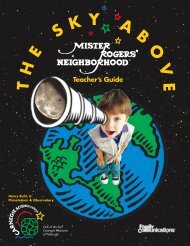
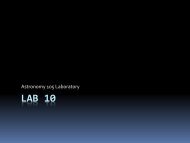
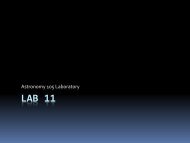
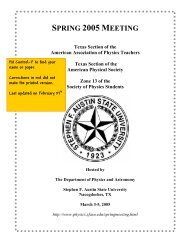
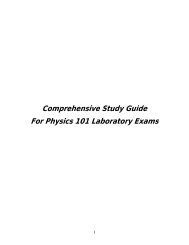

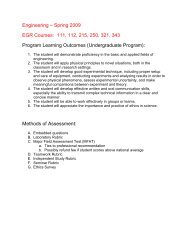
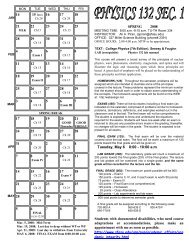
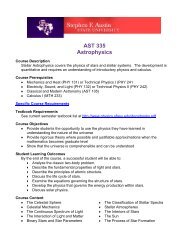

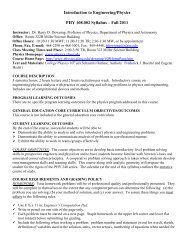
![[pdf] physics 110 fundamentals of electronics](https://img.yumpu.com/29312006/1/190x245/pdf-physics-110-fundamentals-of-electronics.jpg?quality=85)
